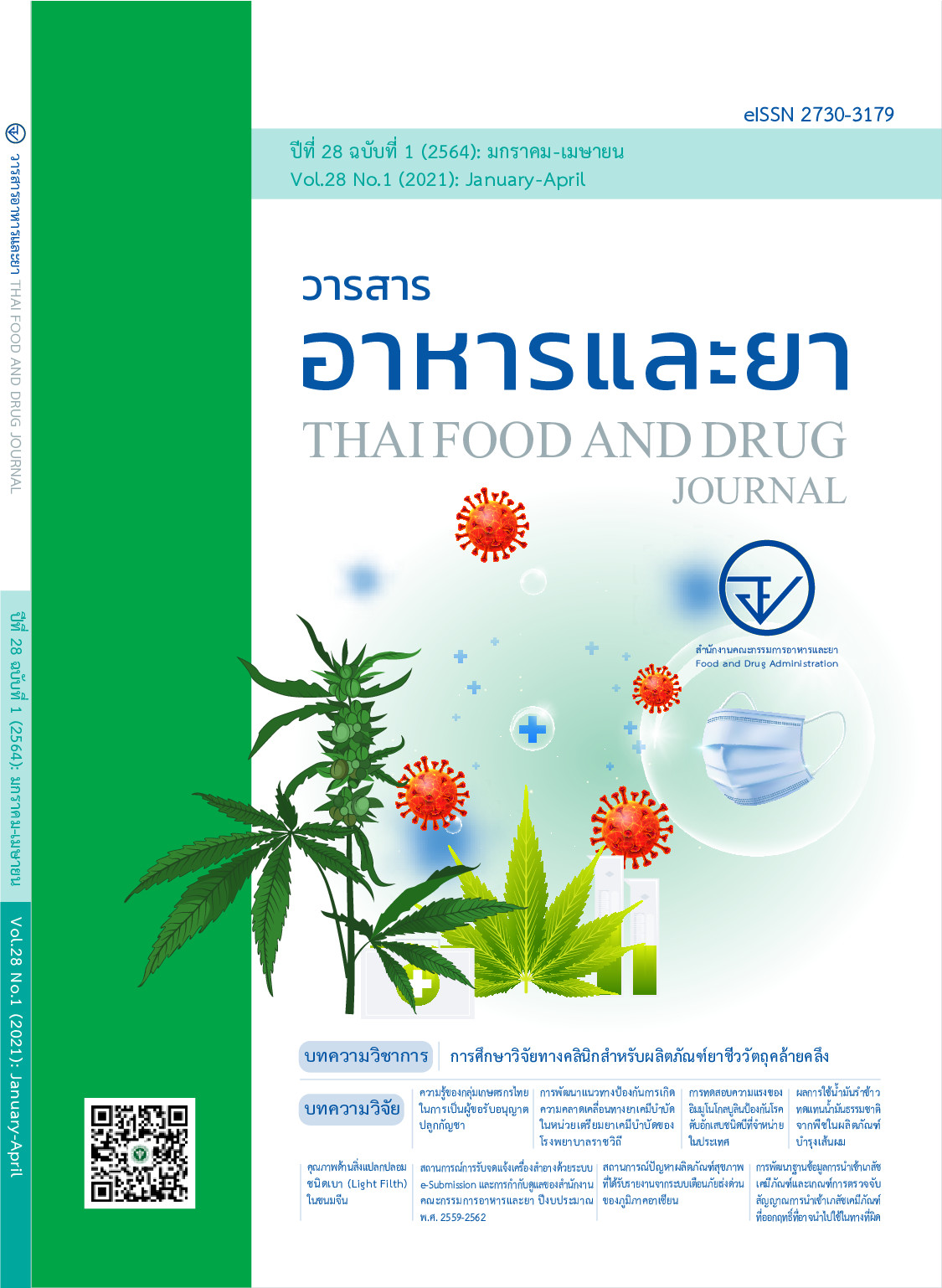คุณภาพด้านสิ่งแปลกปลอมชนิดเบา (Light Filth) ในขนมจีน
Main Article Content
บทคัดย่อ
ความสำคัญ: ขนมจีนเป็นอาหารแปรรูปที่บรรจุในภาชนะพร้อมจำหน่ายซึ่งต้องมีการควบคุมการผลิตให้เป็นไปตาม จีเอ็มพีขั้นพื้นฐาน หรือ “Primary GMP” ดังในประกาศกระทรวงสาธารณสุข (ฉบับที่ 342) พ.ศ. 2555 โดยมีข้อมูลผลการศึกษาคุณภาพด้านเคมี กายภาพ และจุลินทรีย์ แต่ยังไม่มีข้อมูลด้านสิ่งแปลกปลอมชนิดเบา (light filth) ซึ่งเป็นสิ่งที่น่ารังเกียจมองไม่เห็นด้วยตาเปล่า และเป็นตัวบ่งชี้ถึงสุขลักษณะในกระบวนการผลิต วัตถุประสงค์: เพื่อประเมินคุณภาพและความปลอดภัยของขนมจีน
วิธีการวิจัย: ได้ศึกษาสิ่งแปลกปลอมในขนมจีน จำนวน 120 ตัวอย่าง ด้วยวิธี AOAC 982.32, Light Filth in Rice Flours (Powders), Extruded Rice Products, and Rice Paper
ผลการศึกษา: พบสิ่งแปลกปลอมในทุกตัวอย่าง ได้แก่ ชิ้นส่วนแมลง ขนคน ไร ขนนก ขนหนู เหาหนังสือ และขนแมว/สุนัข จำนวน 120, 103, 90, 63, 56, 41 และ 36 ตัวอย่าง คิดเป็นร้อยละ 100.0, 85.8, 75.0, 52.5, 46.7, 34.2 และ 30.0 ตามลำดับ พบขนมจีนไม่ผ่านเกณฑ์ข้อกำหนด DAL (Defect Action Levels) ของ US. FDA เนื่องจากพบชิ้นส่วนแมลงมากกว่า 225 ชิ้น จำนวน 52 ตัวอย่าง คิดเป็น ร้อยละ 43.3 และพบขนหนูมากกว่า 4.5 เส้น จำนวน 1 ตัวอย่าง คิดเป็น ร้อยละ 0.8
สรุป: พบสิ่งแปลกปลอมในทุกตัวอย่างของขนมจีน ดังนั้น ผู้ผลิตควรมีการควบคุมกระบวนการผลิตทุกขั้นตอน โดยนำหลักเกณฑ์และวิธีที่ดีในการผลิต (GMP) มาใช้ เพื่อประกันคุณภาพผลิตภัณฑ์ขนมจีนให้เป็นที่ยอมรับของผู้บริโภคต่อไป
Article Details

อนุญาตภายใต้เงื่อนไข Creative Commons Attribution-NonCommercial-NoDerivatives 4.0 International License.
เอกสารอ้างอิง
สำนักงานมาตรฐานผลิตภัณฑ์อุตสาหกรรม. มาตรฐานผลิตภัณฑ์ชุมชน ขนมจีน (มผช. 500/2547) [อินเทอร์เน็ต]. กรุงเทพฯ: สำนักงาน; 2547 [เข้าถึงเมื่อ 10 ต.ค. 2562]. เข้าถึงได้จาก:http://tcps.tisi.go.th/pub/tcps500_47.pdf
อุไรวรรณ์ ฮวบเจริญ. สรุปผลการดำเนินโครงการสำรวจสถานการณ์ความพร้อมของสถานที่ผลิตขนมจีนเพื่อบังคับใช้มาตรฐาน GMP กฎหมาย. นนทบุรี: หน่วยเคลื่อนที่เพื่อความปลอดภัยด้านอาหาร กองควบคุมอาหาร สำนักงานคณะกรรมการอาหารและยา; 2551.
สำนักงานคณะกรรมการอาหารและยา. เปิดประตูสู่ “อย. Primary GMP มาตรฐานอาหารไทยสู่ครัวโลก”.วารสารอาหารและยา 2556;20(1):78-82.
ศศิมน ปรีดา. มาตรฐานอาหารในประเทศเพื่อการควบคุมคุณภาพและการประกันคุณภาพ. นนทบุรี : มหาวิทยาลัยสุโขทัยธรรมาธิราช; 2559.
เนาวรัตน์ แตงไทย, นวรัตน์ ศยามล, ภัทราวรรณ วัฒนศัพท์, พิทยา เหล่าสมบัติ. คู่มือการตรวจสถานที่ผลิตตามหลักเกณฑ์วิธีการที่ดีในการผลิตอาหารแปรรูปที่บรรจุในภาชนะพร้อมจำหน่าย (Primary GMP). [อินเทอร์เน็ต]. นนทบุรี: สำนักงานคณะกรรมการอาหารและยา; 2555 [เข้าถึงเมื่อ 10 ต.ค. 2562]. เข้าถึงได้จาก: https://www.fda.moph.go.th/sites/food/Unit/1.1-PrimaryGMP55.pdf
กัลยาณี ดีประเสริฐวงศ์. GMP กฎหมาย Updates [อินเทอร์เน็ต]. นนทบุรี: สำนักงานคณะกรรมการอาหารและยา; 2551 [เข้าถึงเมื่อ 10 ต.ค. 2562]. เข้าถึงได้จาก: http://food.fda.moph.go.th/data/document/2554/GMP4-2_LAW_Information.pdf
Whitlock LL. Official Method of Analysis of AOAC International. 19th ed. USA: Maryland 20850-3250; 2016.
Gentry JW, Harris KL, Gentry JW, Jr. Microanalytical entomology for sanitation control. Florida: LithoGraphics Altamonte Springs; 1991.
Food and Drug Administration Center for Food Safety and Applied Nutrition Department of Health and Human Services. Food Defect Action Levels. USA: Washington DC; 1995.
พลอยชมพู กรวิภาสเรือง. ไรศัตรูผลิตผลเกษตร. ใน: อมรา ชินภูติ, รังสิมา เก่งการพานิช, ลักขณา ร่มเย็น, อัจฉรา เพชรโชติ, บรรณาธิการ. การควบคุมศัตรูผลิตผลเกษตร. กรุงเทพฯ: อาร์ตควอลิไฟท์; 2551. หน้า 185-199.
ลัญญณัฐ ภาตะนันท์. การศึกษาศักยภาพสถานประกอบการผลิตเส้นขนมจีน ในการปฏิบัติตามหลักเกณฑ์วิธีที่ดีในการผลิตอาหาร (GMP). กรุงเทพฯ: สาขาวิชาการบริหารเทคโนโลยี วิทยาลัยนวัตกรรม, มหาวิทยาลัยธรรมศาสตร์; 2522.


